Diving WWII Wrecks, Coron Bay Philippines

Peregrina's Journey
Peter and Margie Benziger
Fri 26 Oct 2012 01:27
Diving WWII Wrecks
On the morning of September 24, 1944, crews from a dozen Japanese
warships awoke to a calm sea and a golden sun in the protected waters of Coron
Bay, Philippines. This was to be a
morning of rest after the ships had hurriedly steamed hundreds of miles south
from Manila to escape the reach of the US Navy air fleet patrolling that area.
Shortly after sunrise, and without warning, the morning’s
silence was shattered by the screaming roar of the powerful engines of 24
Curtiss SB2C-3 Helldiver Bombers supported by 96 Grumman Hellcat Fighters. These aircraft had been launched from the
U,S. aircraft carriers Lexington, Intrepid and Cabot. The aircraft had flown for three hours, an extreme
range even with wing tanks, and had fuel for only 20 minutes over their targets
before they would be forced to return.
But, 20 minutes was enough and, very shortly, 12 Japanese
ships lay on the bottom of the ocean.
The Helldiver Bombers, carrying 1000 pound explosives and
the 500 pound bombs of the Hellcat Fighters had set ships afire, blown holes right
through the bottom of the hulls and torn topsides into a jagged labyrinth of
twisted metal. The sun was blotted out
by the pall of burning bunker fuel oil smoke.
This past week, with Peregrina anchored in Coron Bay, it was
a great opportunity for me to dive on this piece of history. Margie is not
comfortable doing hull penetration dives requiring diving lights so I went on
three dive trips with the Sea Divers Company which specializes in wreck diving.
We traveled to the wrecks in long hulled vessels with bamboo outriggers and
usually did three dives every day.
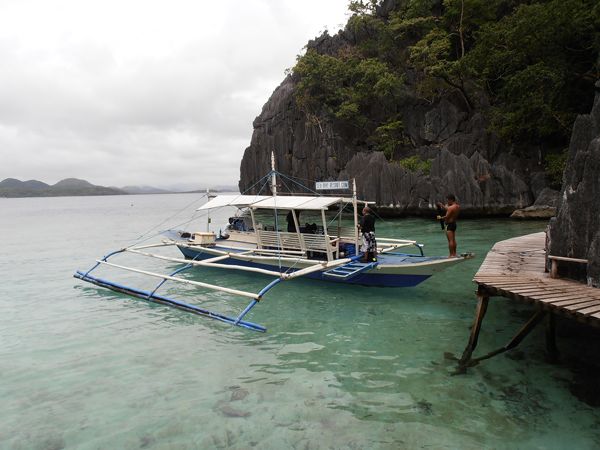
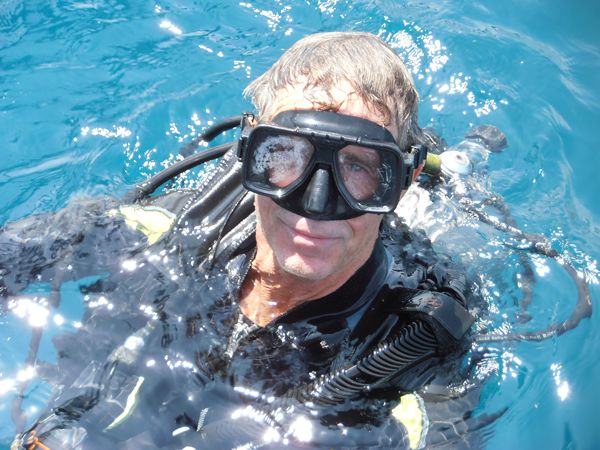
Over the course of a week I dove on the following Japanese
wrecks. The picture below is of the Iraki before it was sunk.

|
Ships Name
|
Length
In feet
|
Description
|
Maximum
depth in
feet
|
|
Iraki Marui
|
650
|
Refrigeration
ship
|
130
|
|
Akitsushima
|
585
|
Giant
seaplane launcher, deck mounted anti-aircraft guns
|
124
|
|
Kogo Maru
|
585
|
Armed
freighter with anti-aircraft guns
|
111
|
|
Olympia
Maru
|
520
|
Armed freighter
|
88
|
|
Tangat
|
397
|
Armed
freighter
|
98
|
|
Sangat
|
114
|
Subchaser
|
59
|
|
Luzon
|
98
|
Armed gunboat
|
49
|
Each dive lasted about 35-45 minutes. On the deeper dives, some divers used a Nitrox
mixture. Normal air is 70% Nitrogen and
21% oxygen. Nitrox reduces the percentage of nitrogen in air and replaces it
with higher than normal levels of oxygen. This
allows the divers to stay down longer and requires shorter decompression stops
as one ascends. I was diving with
regular air so that I had to adhere to the full schedule of decompression stops
on the return. One of the reasons I
chose Sea Divers was the fact that they have the region’s only decompression
chamber at their facility in Coron Town.
Thankfully, I had no use for it…
In all the wrecks we explored, we used diving lights to
illuminate the interiors. This is a picture of me coming out of a
round access hole in the hull.
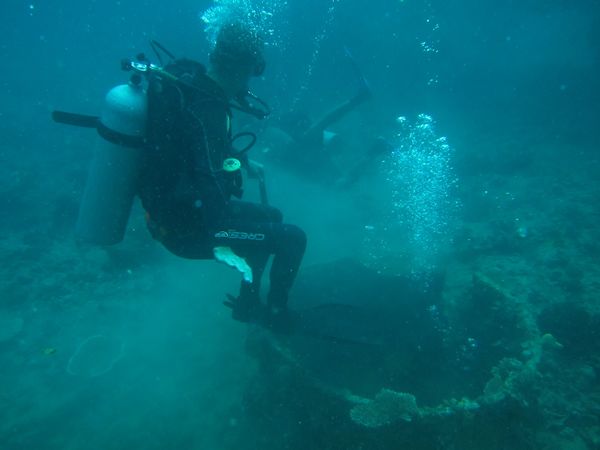
Here’s a picture of the inside of the ship with one of our
exit holes. On the deeper level dives, there is absolutely no light so I,
unfortunately, don’t have any pictures. When you are down inside the hull, you
are REALLY out of luck if your dive light goes out as it is completely black.
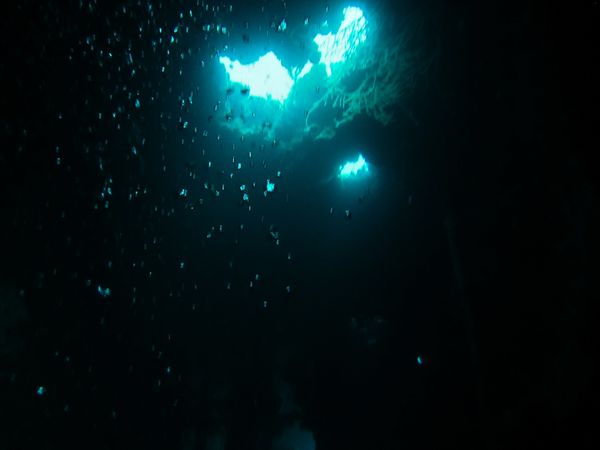
We came across a cannon shell lying on the deck of the one
of the ships
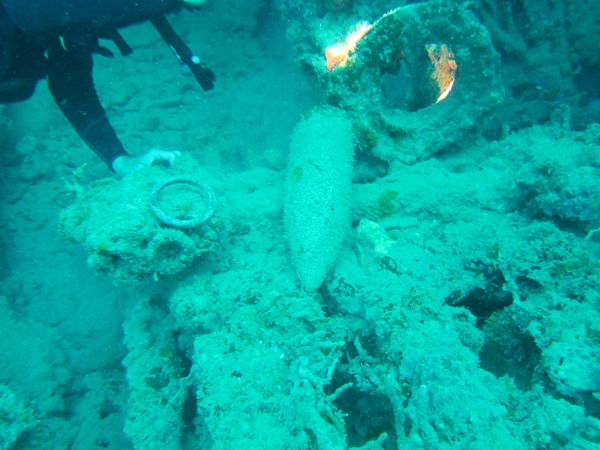
If you saw the movie Finding
Nemo, you will recognize these little clown fish.

You may also recognize a Moray eel.
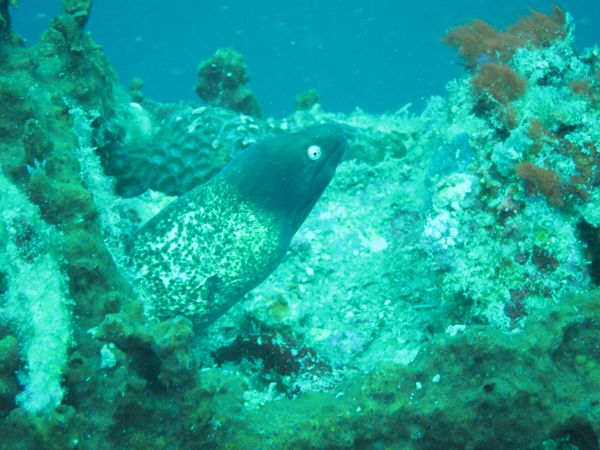
And don’t try to blow more air out than this Puffer fish!
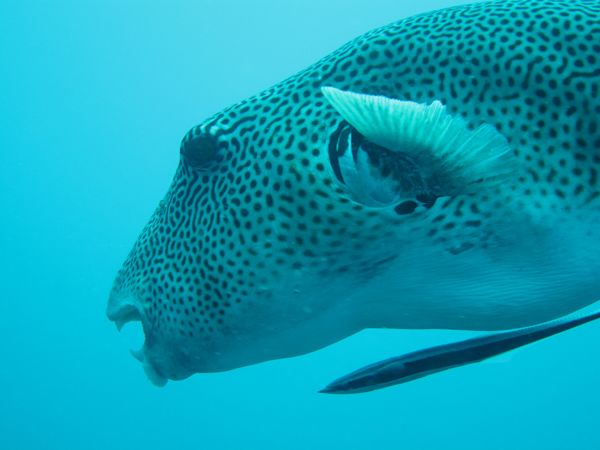
Diving on
these Japanese ships was an emotional journey for me. Deep inside one wreck, we saw a complete set
of teeth and jawbone of one of the sailors who died. It was sitting on what
looked like a shoe or boot sole. Swimming through a passage, I picked up a long
piece of water resistant timber that was clearly burned on all sides. Many of
the ships had metal beams literally bent in smooth angles that must have been
melted by the burning fuel. All vessels
were filled with large areas of jagged metal ripped asunder by the bombs. Swimming inside the hulls, we had to be
careful that our diving gear did not catch and rip on the rusted and coral
covered metal. In the picture below I am
about to enter a tight hole.
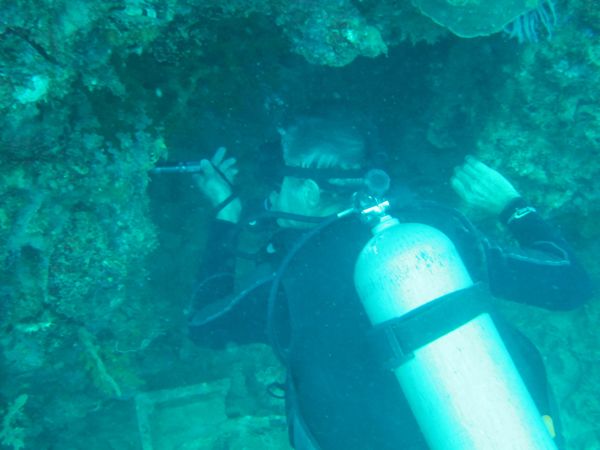
It was unnerving to
think that, underneath all the silt we were swimming over, hundreds of bodies
had been burned, blown apart or drowned on that day in 1944 and were resting
right below us, hidden from the glare of our dive lights.
Thoughout Peregrina’s journey, we have had the opportunity
to visit sites of World War II prison camps, land battles, air attacks and
naval engagements. In all of these locations allied soldiers, as well as
Japanese soldiers, died fighting for their country.
I know that there are no winners in war and that, in the
end, everyone loses. After Margie wrote the story of Corregidor, we received
the following note from a US veteran, James Range, who must be very, very old
now. He wrote:
“I was in the South Pacific in the 2nd World War with the
1st. marine division, from May 1942 until Nov 1944. We were in
Guadalcanal, Goodenough Island, the Pavau Islands Campaign and the Battle
of Peleliu. We made the first invasion of Japan in the 2nd World War. Never
made it to Corregidor, thank God. It was HELL!”
I was so moved that I wrote back to him:
“Dear James,
The only thing I can say to veterans like you is "Thank
you." I doubt I will ever be able to appreciate the sacrifices
you made for your country and for our generation. The more I travel around the
world and see the battle grounds, the more I fully understand that you were the
heroes that made our present life possible. Thank you.”